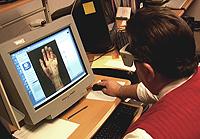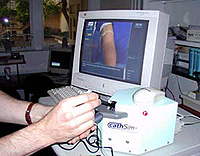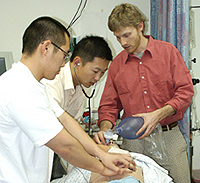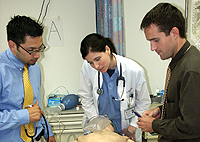ISL in Undergraduate Medical Education
Students are an important and growing target population for a variety of applications of immersive and simulation-based learning at Stanford School of Medicine. ISL is deployed at every level of medical student education and training.
Pre-clinical Education and Training

Virtual Reality and Internet-based Simulation: Interactive (often 3-D) visualization software is used to teach anatomy using virtual reality techniques. Students also have access to a number of web-based or computer-based modules, for example on nutrition, and “virtual patients” that can be seen and queried on the computer screen. Students are also encouraged to use third-party interactive web-based teaching resources made available by others in the world-wide ISL community.
Standardized Patients: Based on the premise that, in many situations, the best simulation of a human being is a human being, Stanford has a very active Standardized Patient (SP) program with a large cadre of actors who portray a large number of diseases and conditions and a diverse set of patient-physician interaction challenges.
SP exercises are an important part of students’ learning and practice in the art and science of interviewing patients to obtain a medical history, or conducting physical examination, and of communicating with patients in a variety of encounter settings. Over the course of medical school students will be exposed to about 25 SP encounters – half in the pre-clinical phase of learning, and half in the clinical phase (there are SP exercises or simulation sessions in nearly all core clerkships).
More information about the Standardized Patient Program can be found here.

Part-task Trainers: Learning specific “psychomotor” skills such as the elements of conducting a physical examination, or procedures such as blood drawing (“venipuncture”) or spinal tap (“lumbar puncture”) can be greatly assisted by the use of part-task trainers. Second-year medical students in the Practice of Medicine course (POM) use part-task trainers in the ILC to learn various procedures including:
- Cardiac auscultation
- Pelvic examination
- Venipuncture/IV insertion
- Airway management
- ECG interpretation
- Lumbar puncture

Mannequin-based Simulation: Second year students in the POM course undergo the simulation-based Introduction to the Management of the Ill Patient (IMIP) course. This entails a 2 hour session with small groups of students and an instructor interacting directly with a high-fidelity mannequin-based simulator in an emergency room setting.
Unlike a live actor, the simulator can have life-threatening illnesses; can be given invasive treatments such as IV drugs, needles and tubes; and can even undergo cardiac arrest (e.g. from a heart attack) or cardiovascular collapse (e.g. from severe allergic reaction). The IMIP course is designed to introduce students who have largely been exposed to patients and exercises in relatively static environments like the outpatient clinic or ward to the world of acutely ill patients as might be seen the emergency department or the intensive care unit.
Clinical Education and Training
A variety of the same modalities indicated above are also used during clerkship rotations and sub-internships in the clinical phase of education and training.
Clerkship Simulations
Part task training
- Obstetrics and Gynecology - fetal delivery part-task trainer
- Anesthesiology - endotracheal intubation part-task mannequin
Standardized Patient Scenarios
- Family Medicine
- Ambulatory Medicine
- Pediatrics

Mannequin-based Simulation Exercises:
- Critical Care Clerkship (1 half-day session)
- Anesthesia Clerkship (2 half-day sessions)
- Surgery Clerkship
- Obstetric and Gynecology Clerkship
- Medicine Clerkship Bedside Rounds
- Emergency Medicine Clerkship
Surgical and Procedural Simulation:
- Surgery
- Vascular Surgery

